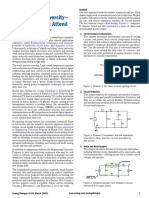The Self, Presence and Storytelling
Thomas GripFrictional Games, Helsingborg, Sweden thomas frictionalgames com (please fill in blanks yourself)
Last updated: 10 September 2012
Who am I?
I am Thomas Grip, creative director at Frictional Games, a company most known for
Amnesia: The Dark Descent
(2010). I have been doing commercial horror games for over 6 years as part of Frictional Games and have over 10 years of experience as a hobby developer in the same genre.
Introduction
This paper is essentially an extended version of a talk that I first gave at the Game Developer Conference Europe (GDCE) in 2012. The goal is to present a new way of designing games that can give rise to better storytelling. It represents an accumulation of knowledge from creating horror games and has been reformed into a more general theory. Hopefully, it can be used for any sort of game that wants to tell a story.The paper is structured so the basic information is given in the first part of each section. It then presents more in-depth information in "Further Information" at the end. This can be skipped for readers that are only interested in a general idea of the design approach.
Stories and Black Boxes
Story does not really have an objective definition, nor do I think there needs to be one. Still, in order for this much of the content below to make sense, a definition is required. The one that will be used here is one that is common in both film and literature. Basically, a story is something dealing with: theme, setting, characters, plot and narration.The theme is whatever it is that the story is trying to tell the audience. One could also call this essence or meaning. The setting includes things such as the environment and background information, i.e. data on the world that the story is set in. Characters are the people
that make up the story. Plot is a string of events that happen over the course of the story. Finally, narration is the way in which the story is told to the audience. This means that any game that has a focus on one or more of these elements is a game with storytelling. For instance,
Final Fantasy
(Square Enix, 1987) has plenty of storytelling and
Tetris
(Nintendo, 1989) has none.
1If you want to be more technical, I guess "actor" or "agent" are better words.2Although one could argue that
Tetris
does have some tiny fragments of a story (given the definition) I think that is simpler to just say it has no storytelling at all. Another important point is that
Tetris
has no intent of telling a story,
with games that are entirely about storytelling on one end, none at the other, and everything else in between. In this paper I will discuss video games with a focus on storytelling. This is important to keep in mind as some examples are not really valid for video games that have minimal storytelling efforts. There will, of course, always be borderline cases, but I do not think that will be a problem for the issues discussed.Crucial to keep in mind is that the story is
not
just the plot or a set of predefined events; it is anything that deals with the elements listed above. Here is where the interactive part comes in. There is not much interactive that can be done with a plot other than choosing paths from time to time. But characters, setting and so on are things that we can properly interact with.
Interactive
storytelling means we want the player
play
the story, not just passively observe it.It might not be apparent at first glance, but horror games are very focused on interactive storytelling. By this I do not mean the plot, but the goal to put the player inside a narrative. Horror games really thrive on this and fail without proper horror themes, characters and settings. This has led to us at Frictional Games to struggle with interactive storytelling for some time, and the experience and research we have gathered serves as a foundation for this paper. The goal is to present an alternative way of designing games, but before going into that the current state of storytelling must be discussed.The first and most common type of storytelling technique is to have a linear string of gameplay sections bound together with cut-scenes. These games almost always begin with a few basic mechanics (usually jumping and shooting) that create the core gameplay experience. The game is then divided up in sections where the player is engaged in these mechanics. In order to tie these together or just have the protagonist perform other actions, some form of cut-scene
is used. Examples of games using this are:
Uncharted
(Sony, 2007),
Another World
(Interplay, 1992),
Call of Duty
(Activision, 2003) and
Half-Life
(Valve, 1998).The next type is quite similar to the previous. Again, it starts off with a few basic mechanics, but instead of a linear string of sections, the player is set loose in an open world to explore. To handle things unrelated to the core mechanics there are quests and expositions scattered throughout the game. Video games built around this concept include
Skyrim
(Bethesda, 2011),
Bioshock
(Irrational Games, 2007) and
Ultima
(Electronic Arts, 1980). The important take away here is that in both these techniques most of the gameplay time is spent repeating the basic mechanics. The other parts are just non-interactive (or at least severely less interactive) filler.If we move away from these kinds of storytelling, games tend to remove all of the dynamic gameplay flow and interaction happens at a much higher level. The player tells the avatar to go here, chooses from a list of actions and so forth. All of these actions are very discrete and lack the flow that you can see in the games mentioned above. Controlling Nathan Drake in
Uncharted
(Sony, 2007) as he jumps and shoots bad guys is very different from how you control Guybrush in
Monkey Island
(LucasArts, 1990-2011). There is a much greater sense of fluency.
However, all of
while the opposite is true for
Final Fantasy
.3I consider the type of scenes you see in
Half-Life
to be cutscenes. It might be in-game, but the player cannot really do anything besides stand and look.4Note that this is different from flow as coined by Mihály Csíkszentmihályi in
Flow: The Psychology of Optimal Experience
(1990) for when you are really into something. While the type of gameplay that I discuss can, and often has, a sense of flow in Csíkszentmihályi's sense, this is not what I mean. By fluency I mean that there is a constant flow of input to the player and the feedback is very responsive. There are all sort of degrees of this and not just a
these games focus on combat; they lack the range of actions that can be done in games like
Monkey Island
.Looking at the history of these fluent games, we see that that the storytelling has remained very similar.
Uncharted 3
(Sony, 2011) uses the same some kind of technique that
Another World
did, and
Skyrim
is not all that different from a game like
Ultima.
This means that for the past 20 – 30 years very little has changed in how stories are told. There are many aspects of gaming that have gotten better, but the basic storytelling structure is essentially the same. It is quite clear that something is holding back progress, but what?My suggestion is that the problem lies in the foundational design principle for these games. At the core of this design is a black box, a system unknown to the player. The goal is to intuitively figure out and master this box by interacting with the game's mechanics. For instance, in
Super Mario Bros.
(Nintendo, 1985), the mastery of jumping allows one to better traverse the games many chasms. Another example is how intuitive knowledge of the weapons in
Counter-Strike
(Valve, 2000) gives the player an edge over her opponents. I will refer to this as “black box design” throughout this paper.When designing a game using this approach, it is essential that the mechanics of the black box have certain properties. They must be crafted in a way that makes the kind of intuitive learning and mastery previously mentioned possible. For this to happen the output from the mechanics must promote intuitive understanding. They must also include some form of mastery that the player can improve on after practice. Both of these requirements reinforce one another and almost always lead to some sort of competitive gameplay. In the end, only specific kinds of actions fit these requirements, reducing the space of activities possible.Also, black box design encourages an optimization of focused play style where choices made are based on the mechanical gain instead of emotional attachment. For instance, the player will be drawn towards using the weapon that is most effective mechanically, rather than the one with most pleasing aesthetics. Because the design rewards mastery, any suboptimal decisions should give the player negative feedback. The player can, of course, to try ignore the feedback, but as this leads to a less engaging experience, it is very hard to do for any longer period of time.
In order to have good storytelling it is imperative that the path of optimization is the same as the emotional one. For instance, when a player kills the bad guys from emotional instinct in shooter, this is also in line with the optimal strategy.That sums up the biggest reason why storytelling games end up the way they do. With these limitations it is very hard to come up with good black box mechanics besides combat and movement.
The rest of the paper will now present an alternative to this black box design
.
My hope is that the theory will allow games having a large set of actions feel fluent and be
playable
all the way through.
Further Information
I think that Raph Koster's book
A Theory of Fun
(2004) is a good introduction to black box design.
binary property, but I still it is possible to in general terms speak of gameplay of either fluent or not, as the occurence of a middle ground case is rare.5The first
Ultima
from 1980 is really simple and is missing many of the finer points in the storytelling; it is mostly about combat. So I can understand that it might feel a bit far-fetched to compare
Skyrim
with it. But one only has to go to
Ultima VI
(1990) to find as good as elements from
Skyrim
.6And it may actually be impossible if the player needs to achieve optimal results in order to progress.7Unless you do something very abstract, but then it gets much harder to tell any kind of story.
While it makes the mistake of claiming that all games must be based around this concept, it sets up good goals for this approach. My paper casts this type of design in a negative light, but it is far from being intrinsically bad. There have been great games released using it. Raph also outlines how this kind of design is fantastic for learning and can help us change the way in which we view the world. My point is merely that it is not suited for a wide range of interactive storytelling, but only for those games that involve killing.Jesper Juul uses a similar case to show how games can never tell stories. I agree with nearly everything he says, apart from where he concludes that games are incompatible with storytelling. Jesper's view on story is also very plot-centric which I do not agree with at all. See here.
A Sense of Self
Before describing the actual design approach, the human mind must be discussed. This will include a lot of neurology and some philosophy, but will eventually come back to video games. The goal is to give a quick overview of how the mind works
and use that to give a basic understanding of how immersion in games is created. It is very to easy to think that what makes up your self is a fixed entity that is not possible to change. When you consider the expanse of your self (your arms, legs, etc.), you have a very firm picture of what is
you
and that it is something set in stone. The reality is quite the opposite; what you consider as your self is highly malleable. What constitutes
you
is constantly in flux and far from a static phenomena. There is a great experiment that shows this in action. Begin by putting a rubber hand on a table, and then ask the subject to put her real hand next to it. A screen is then set up in between to block off the subject's view from the real hand, allowing her to only see the rubber one. The rubber hand and the real one are now continuously stroked in the same place, and after a while the subject will feel as if the rubber hand is her own. This impression can be tested by taking a hammer and quickly hitting the rubber hand with it. The subject will then pull back her real hand, feeling as though it was targeted. This is an unconscious reflex and the same action would not happen if the table was hit further from the hand. It confirms that the subject really believes—not not just on a conscious level—that the rubber hand is hers.A more subtle test is to measure the galvanic skin response (palm sweat)
when threatening the rubber hand with a knife or other weapon. Again, this will produce a response as if the real limb was being threatened.What happens in the experiment is that the continuous stroking of the real finger and the rubber one changes the brain's body image. This unconscious action of pulling away from danger is based upon a new sense of self. This is made possible by the repeated feedback loop that is created by feeling the stroke and seeing where the stroke is being made. If the stroking stops, the illusion quickly fades away. This shows how what we believe to be ourselves can be changed, and that it is the current state of input-output that matters.The same technique has been used to transfer a person's sense of self to different objects.
8Which, while not very common when thinking about the mind in ordinary life, is where all the scientific evidence points at. Some of the views are up for more discussion, but generally what is presented stands on solid ground. This is what 400 years of continually revised science of the brain points towards.9This is wildely used as a measurement for both stress and arousal.


























































































